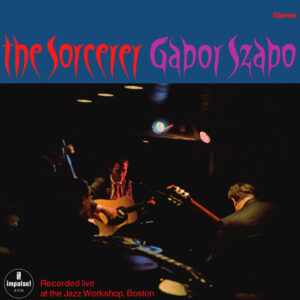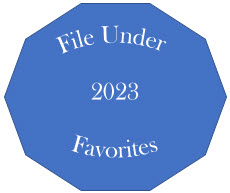The Sorcerer – Gábor Szabó (Impulse)
Hungarian guitarist Gábor Szabó performed the music on The Sorcerer in 1967 at the Jazz Workshop, Boston. His first live recording as a leader, Szabó is joined by guitarist Jimmy Stewart, bassist Louis Kabok, percussionist Hal Gordon, and drummer Marty Morrell. Szabó plays a diverse array of originals, standards, and even a pop tune by Sonny Buono.
It’s fair to say that not many jazz artists have recorded “The Beat Goes On,” but here it is stripped of its sentimental associations, with the emphasis being instead on its backbeat and effusive duo guitar solos. The pairing of Szabó and Stewart is particularly simpatico, with the guitarists trading solos, playing duets, and comping in distinct styles.
“Little Boat” is a samba that gives Gordon and Morrell the opportunity to create a duet of their own, with energetic, overlapping polyrhythms. “Lou-ise” by Stewart embodies Latin rhythms of a gentler variety and is a great showcase for the guitarist. Cole Porter’s “What is This Thing Called Love” begins with a dovetailing guitar duet followed by a buoyant solo by Szabó. Another duet, and Stewart takes a turn. All the time, the rhythm section is bolstering them with a stronger backbeat than one usually hears in performances of standards: rockin’ and rollin’ with Cole. The guitarists trade fours with Morrell, and then bring a bifurcated version of the tune back to close.
Szabó’s “Space” incorporates inflections from Hungarian music as well as swelling sustained guitar notes. The syncopated beats of folk dancing played by Szabó in modal and harmonic minor scales, Gordon’s triangle and cymbals, and repeated harmonies from Stewart combine in the most imaginative arrangement on The Sorcerer. The lilting Parisian ambience of “Stronger Than Us,” by Francis Lai and Pierre Barough, wafts through a circle fifths progression that is ready fodder for soloing.
“Mizrab,” by Szabó, refers to the type of plectrum used on some Iranian and Indian instruments. Once again, the guitarist channels melodic patterns and rhythmic grooves of a different culture, his playing reminiscent of ragas, with Gordon undertaking a rendition of traditional tabla playing. The seven-minute piece is the most developed of any on the album. In an extended closing section, a decrescendo yields to sustained tones and a subdued version of the tune. “Comin’ Back,” a brief rock ‘n’ roll chorus by Clyde Otis and Szabó serves as a rollicking coda to the date.
The quality of the mix is excellent, as are the original liner notes and artwork. It is one of my favorite recordings of 2023.
-Christian Carey


